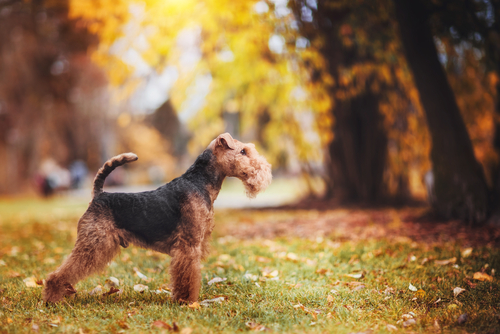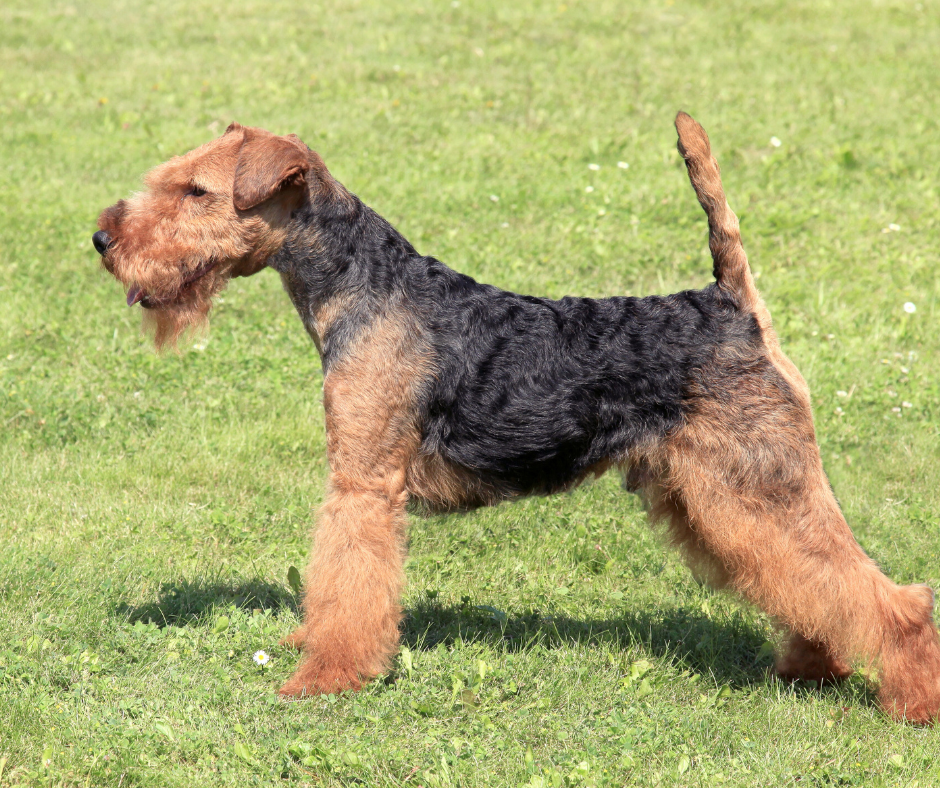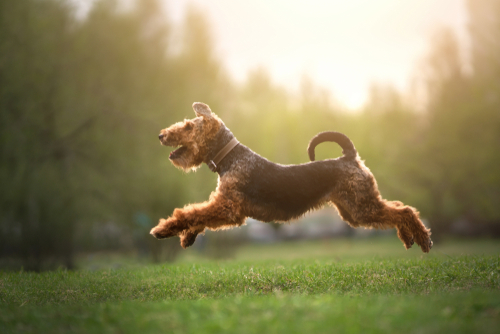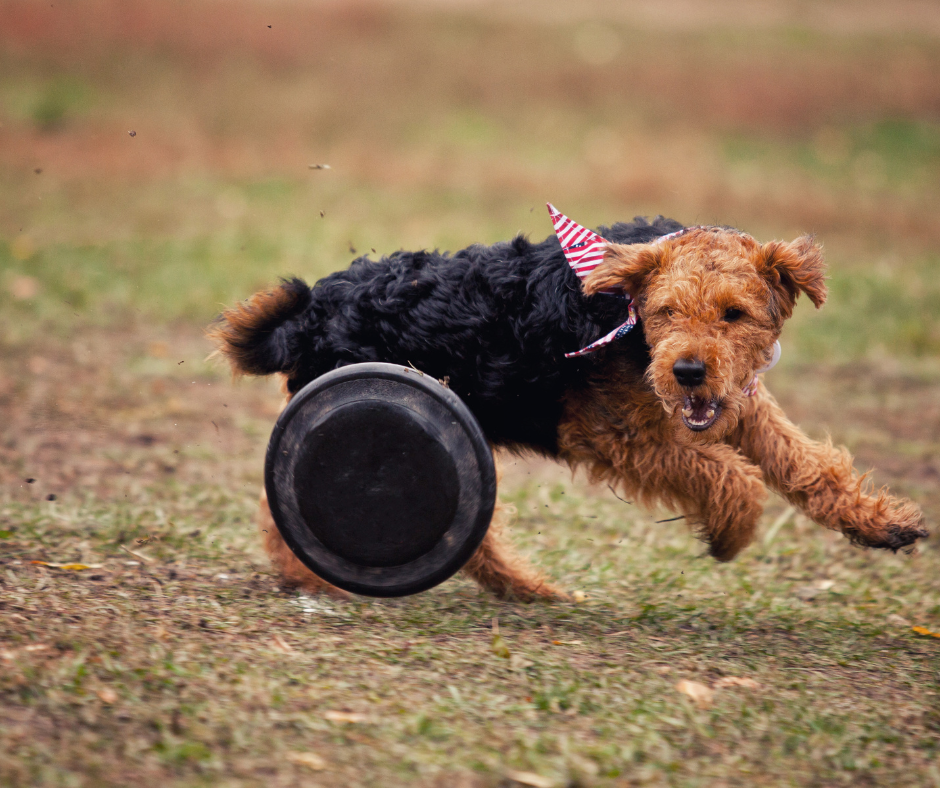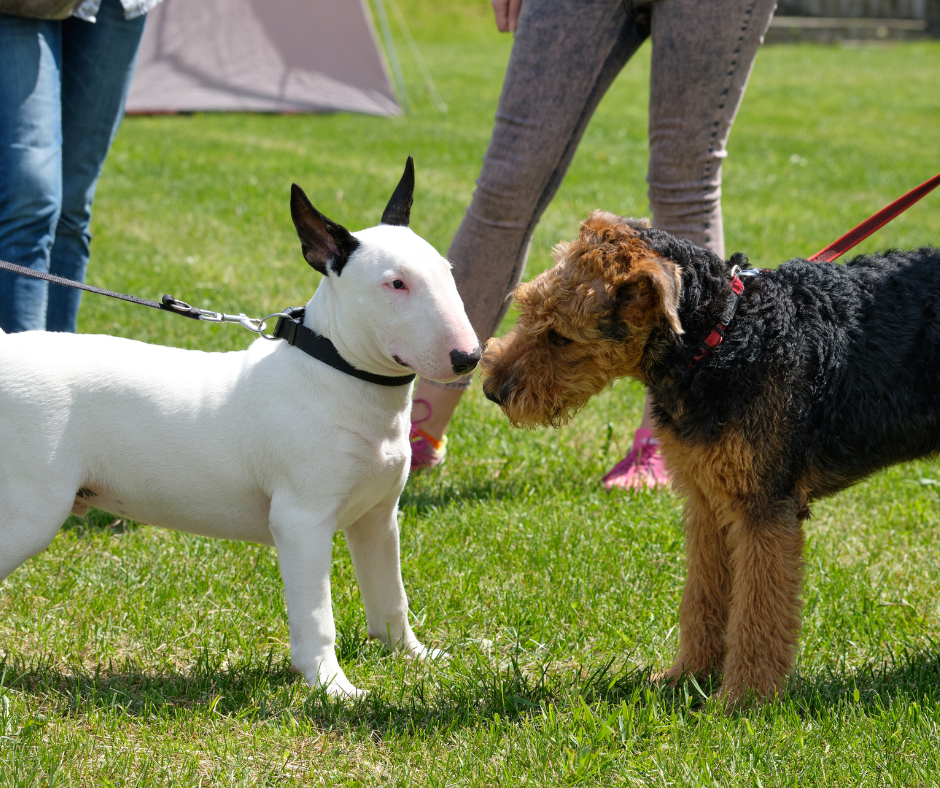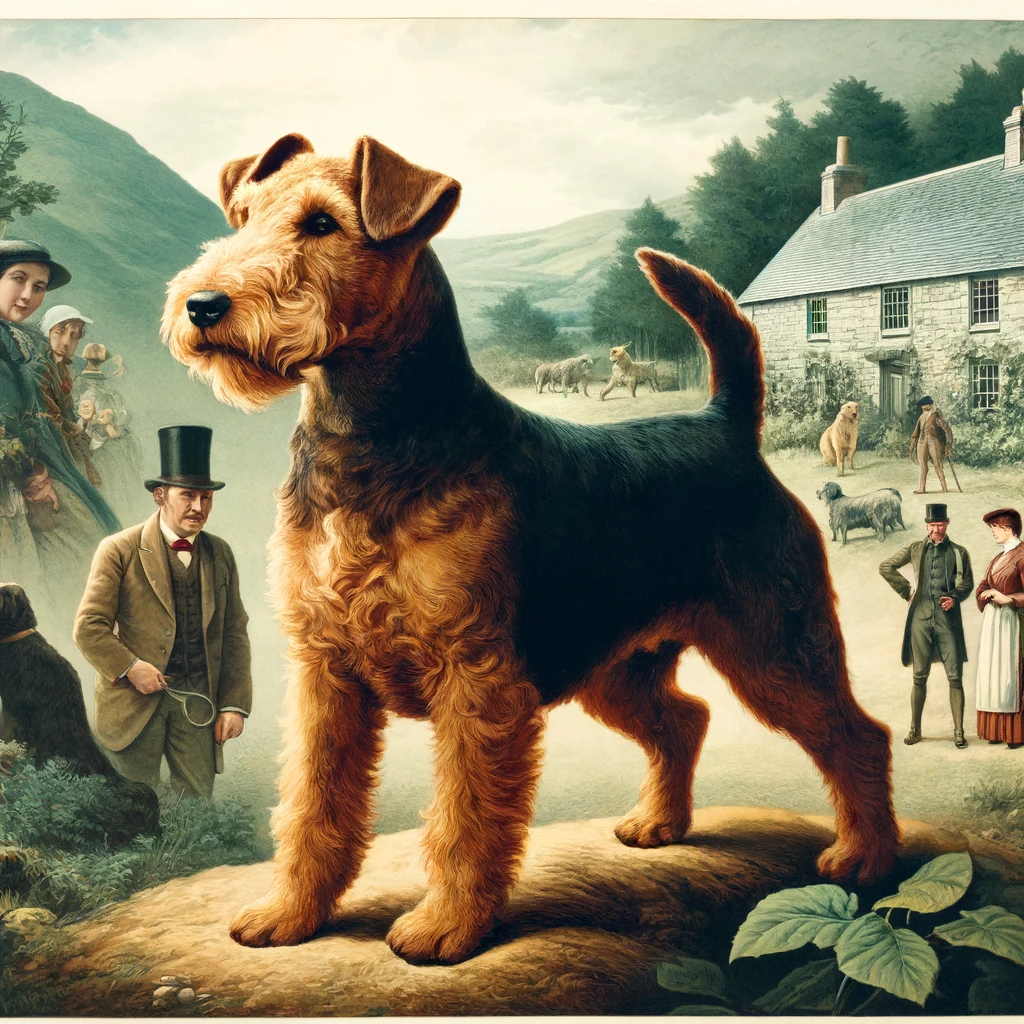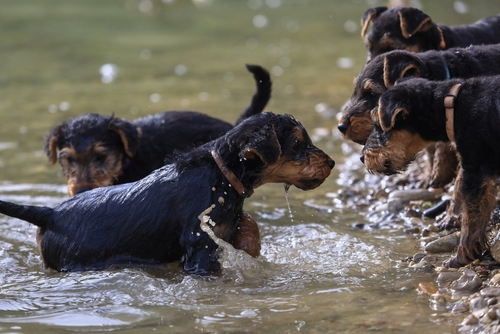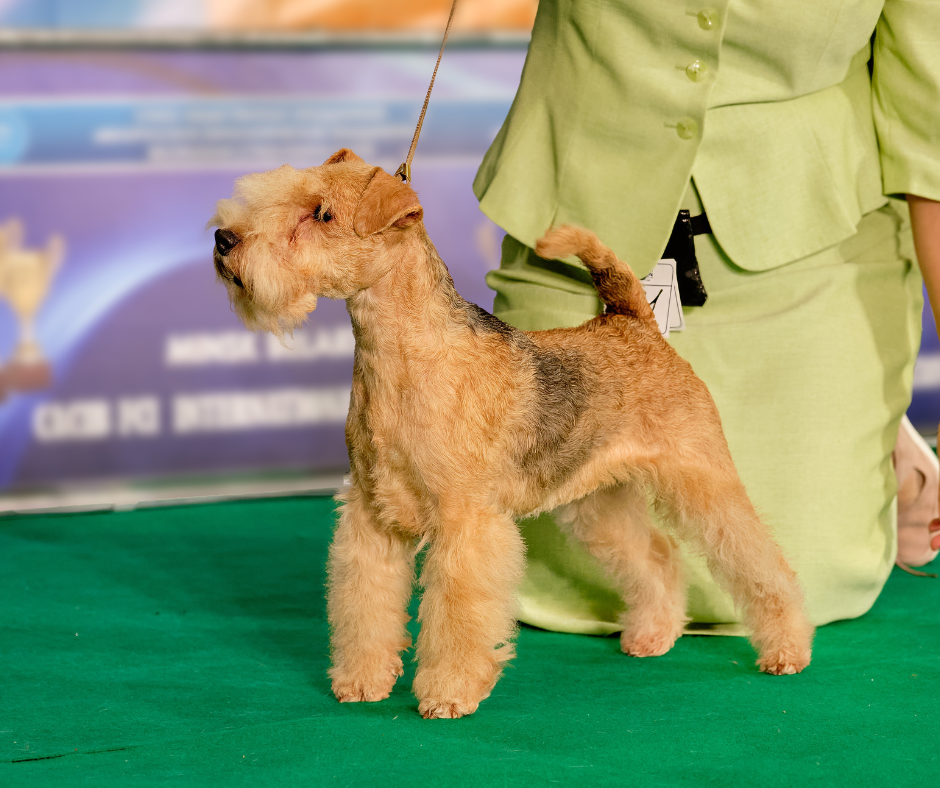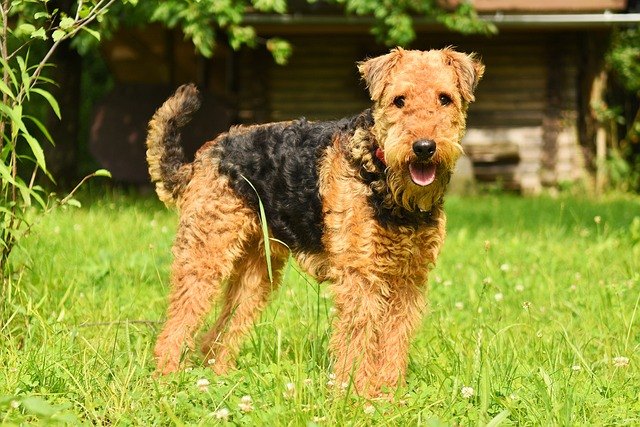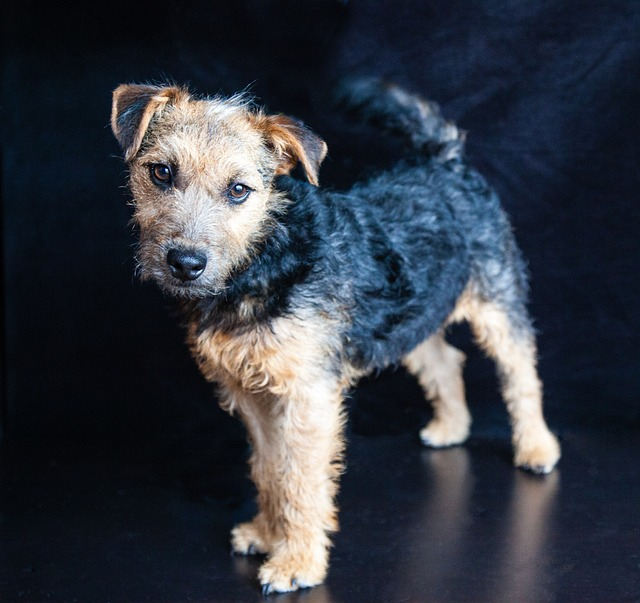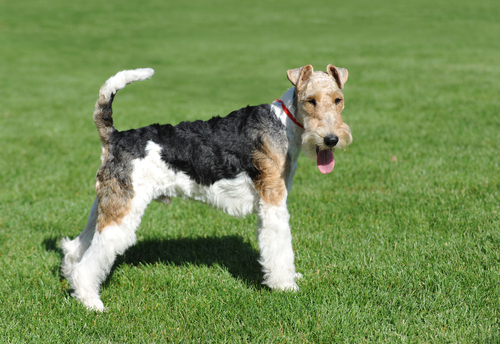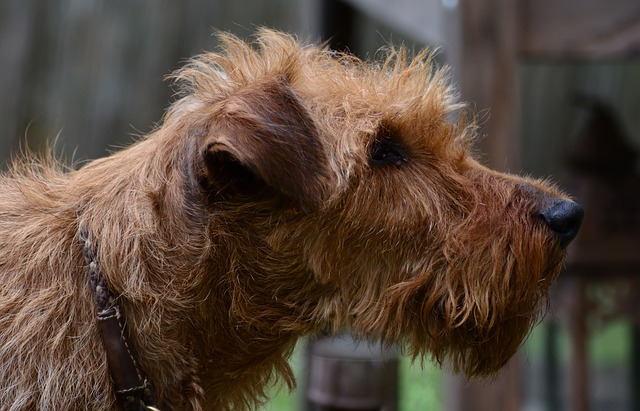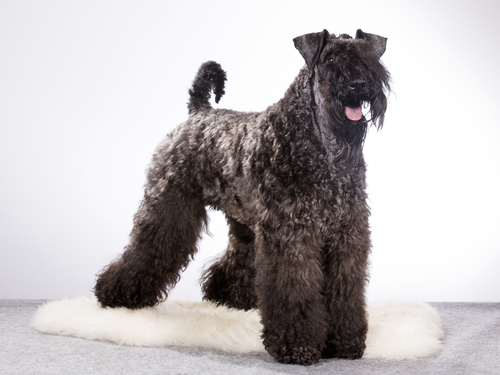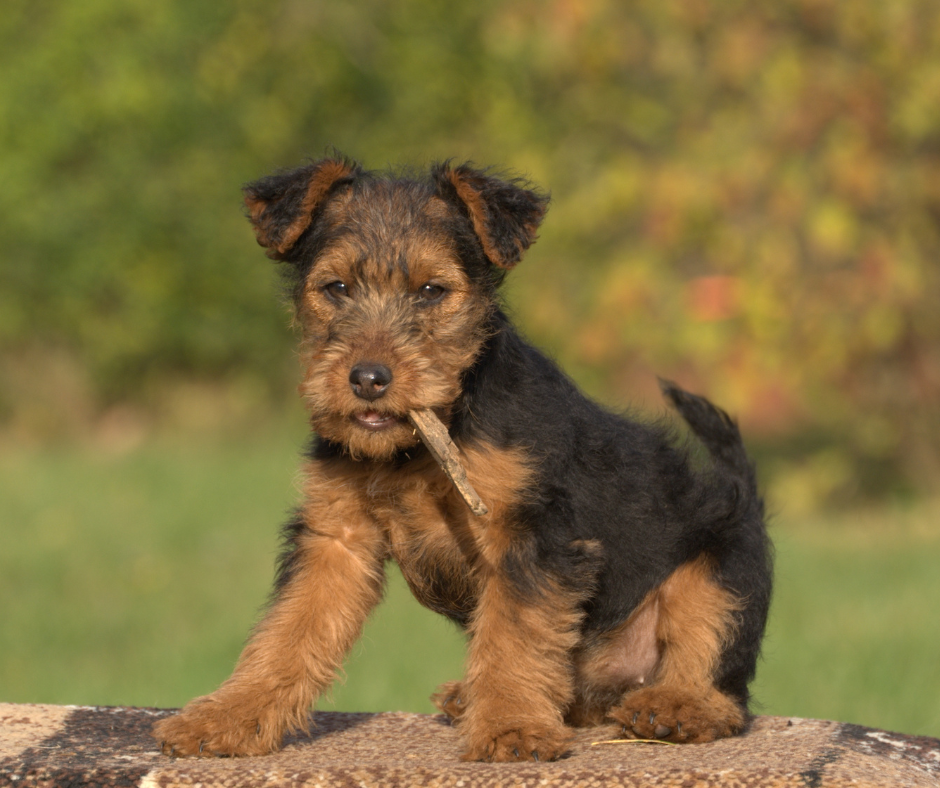Welsh Terrier

Vibrant paintings and prints of old-fashioned wirehaired terriers, resembling present-day Welsh Terriers, depict a breed that originated in Wales. These dogs adeptly faced formidable foes like badgers, foxes, and otters.
The Welsh Terrier is resilient, with a weatherproof double coat. The outer coat is tough and wiry, while the undercoat is soft and short, both in a striking tan-and-black pattern. This distinct color combination ensures he stands out from the crowd.
Confident and independent, the Welsh Terrier is charming and inquisitive, sometimes getting into trouble but also useful for rodent control. To direct his energy positively, engage him in activities like fetch or walks. His medium-sized body, tan fur with a black saddle pattern, docked tail, and folded ears make him easily recognizable.
The Welsh Terrier embodies classic terrier traits—playful, headstrong, and mischievous. While not always great with other dogs and prone to digging or chasing cats, life with a Welsh Terrier is never dull.
Weighing 20 to 22 pounds, the Welsh Terrier can be stubborn and independent. While adorable as puppies, they require firm but affectionate training to prevent them from becoming too controlling. Proper training helps channel their energy constructively.
Without proper training and attention, Welsh Terriers can be a handful. Early training helps redirect their energy into activities like agility sports and earthdog events. Regular exercise, such as leash walks, helps prevent chasing and ensures good behavior at home. While they typically get along with older children, they may not do well with younger ones.
Pet Welsh Terriers need weekly combing and clipping a few times a year, along with occasional baths, to look their best. Show dogs require more meticulous grooming.
Welsh Terrier Essentials: Your Guide to Health, Training, and Care
Considering a Welsh Terrier as your next canine companion? The Welsh Terrier was recognized as a purebred by the American Kennel Club in the late 19th century, establishing its prominence in the United States. Discover what makes this breed distinct with their bold black-and-tan coat, boundless energy, and sharp wit. This comprehensive guide will navigate you through the essentials of Welsh Terrier care, from grooming to exercise, and everything in between. Get a closer look at what life with one of these dynamic dogs entails and whether they match your lifestyle.
Read More: Dog Breeds Not Recognized by the AKC
Key Takeaways
- Welsh Terriers are medium-sized, high-energy dogs with distinctive black-and-tan coats that require regular grooming, including hand-stripping.
- They have lively personalities, are intelligent and need early socialization and consistent training, as well as daily physical and mental exercise to stay well-behaved and happy.
- Welsh Terriers can be great family pets if their exercise needs and health considerations like allergies and joint issues are properly managed.
Welsh Terrier Appearance
Welsh Terriers are the epitome of terrier charm, with their elongated heads, folded ears, and signature cheerful beards setting them apart from other terrier breeds. These are dogs that wear their heritage proudly; from the rectangular shape of their head to their almond-shaped brown eyes, they exude a certain old-world gravitas.
Puppies are a delightful surprise, born with almost entirely black coats that mature into the breed’s iconic black-and-tan markings. As adults, they sport a black-and-tan wiry coat with a softer undercoat beneath, a hallmark of the healthy Welsh Terrier. The Welsh Terrier’s coat, known for its wiry and harsh outer coat, requires regular grooming, including brushing and hand-stripping, to maintain its distinctive appearance and health.
Coat and Grooming
Caring for a Welsh Terrier’s coat is an art. Beneath the wiry, harsh outer layer lies a soft, smooth undercoat that requires regular attention. To keep a Welsh Terrier’s coat texture distinctive, Welsh Terriers need frequent combing, brushing, and the ancient art of hand-stripping.
This isn’t just about looking dapper for the dog shows; it’s about maintaining skin health, which is why a grooming routine for your dog should include:
- Regular brushing to remove loose hair and prevent matting
- Bathing every couple of months to keep their skin moisturized
- A visit to the groomer every two to three months to keep their coat stripped, brushed, and clipped to perfection.
Size and Weight
When it comes to stature, Welsh Terriers are the very model of a modern, medium-sized terrier. Standing at about 15 inches tall and weighing around 20 pounds, they are perfectly sized for both cuddles on the couch and adventures in the great outdoors, unlike long legged terriers that may require more space.
Compared to their cousin, the Airedale Terrier, Welsh Terriers are the more petite option, offering all the terrier spunk in a smaller package.
The Spirited Welsh Terrier Temperament
Dive into the world of Welsh Terriers, and you’ll find an intelligent, alert, and friendly companion with an energy that’s as infectious as their curiosity. They are the canine equivalent of a multi-tool, equally adept at playing with children as they are at standing guard over their domain.
Their spirited personality makes every day an adventure, whether they’re tugging at pant legs in a playful gambit or bravely exploring the nooks and crannies of their surroundings. When properly socialized and supervised, Welsh Terriers can get along well with other dogs, though it’s important to note their strong prey drive may not make them suitable for homes with small pets.
Exercise and Mental Stimulation
But a sharp mind and agile body like the Welsh Terrier’s need more than just a run around the yard. They crave challenges that keep them on their toes – both physically and mentally. This means incorporating puzzle toys, varied training sessions, and interactive games that match their mental acuity.
Physical activity is just as vital; they revel in retrieving balls, frolicking in fenced yards, and taking daily walks or runs that stretch their legs and their imaginations. And for those Welsh Terriers with a competitive streak, agility courses and club events provide the perfect outlet for their boundless energy in a fenced yard.
Training and Socialization
Yet, all this spirit needs direction. That’s where early socialization and consistent training come in, shaping Welsh Terriers into well-behaved members of the pack. Starting from puppyhood, training keeps their playful nipping and boundless barking in check and ensures they play nicely with others.
Obedience and puppy classes lay a strong foundation, ideally before they hit the 16-week mark, to mold these pups into the affectionate and obedient companions they’re destined to be. It’s about safety too; managing their strong prey drive is key, especially off-leash, and treats should be used strategically to maintain that healthy Welsh Terrier figure.
Read More: A Guide to Behavioral Training in Dogs
Origins and History of Welsh Terriers
The Welsh Terrier is one of the oldest terrier breeds, with origins tracing back to Wales. This breed was developed in the 18th century, primarily for hunting foxes, badgers, and otters in the rugged Welsh countryside. Its ancestry includes the now-extinct Old English Black and Tan Terrier, from which it inherits its distinctive coloring and wiry coat. Welsh Terriers were highly valued for their tenacity, courage, and ability to navigate rough terrains, making them exceptional working dogs for farmers and hunters.
Throughout the 19th century, the Welsh Terrier’s popularity grew, and it began to be recognized in dog shows. The breed was officially recognized by the Kennel Club in 1887. Over time, breeders focused on refining the dog’s appearance and temperament, maintaining its characteristic alertness and energy while also enhancing its suitability as a companion animal. Today, the Welsh Terrier remains a beloved breed known for its spirited personality, loyalty, and distinctive appearance, continuing to charm dog enthusiasts worldwide.
Read More: A History of Dog Breeding
Caring for Your Welsh Terrier
Every Welsh Terrier deserves a life well-lived, which means regular check-ups to catch any health hiccups early, especially allergies and thyroid issues that can affect this plucky breed. With the right care, these terriers can enjoy an average lifespan of 12 to 13 years, ensuring many years of companionship and fun.
But it’s not just about health; their double coat demands routine grooming, including brushing a few times a week and the occasional trim to keep them looking their terrier best.
Feeding Guidelines
What’s on the menu for a Welsh Terrier? A balanced diet that fuels their escapades is vital, with high quality dog food, specifically designed for small breeds, served up twice a day to keep their energy levels topped up. It’s about finding that sweet spot between proteins, carbohydrates, and fats to support their zest for life.
Remember, an adult dog, particularly a Welsh Terrier, thrives on a twice-daily feeding schedule, so keep those bowls filled and those tails wagging.
Read More: How to Choose the Best Dry Dog Food
Common Health Issues
But just like any dog breed, Welsh Terriers come with their own set of health considerations. Some common health issues to watch out for in Welsh Terriers include:
- Cataracts, which can cloud their vision, a common eye condition in Welsh Terrier dogs
- Primary lens luxation, a frequent eye issue that can threaten their sight, particularly in Welsh Terrier dogs
- Glaucoma, another eye condition that Welsh Terrier dogs are susceptible to, which can lead to blindness if not treated
- Atopic dermatitis, which can cause constant itching and discomfort
- Hip dysplasia, which can affect their mobility
- Patellar luxation, which can also affect their mobility
It’s important to be aware of these potential health issues, especially the eye conditions such as cataracts, lens luxations, and glaucoma that Welsh Terrier dogs are prone to, and to seek medical intervention if necessary.
Vigilance and a proactive approach to these health conditions mean keeping a close eye for any signs of eye trouble or skin irritation and having a vet on speed dial for ongoing treatment plans when needed.
Exercise Requirements
Never underestimate the exercise needs of a Welsh Terrier. They’re not ones for lounging around when there are at least one to two hours of daily activity to be had. Whether it’s a long walk around the neighborhood, a brisk run through the park, or a game of fetch in the backyard, they need to burn energy and indulge their inquisitive nature.
It’s not just about the physical workout; it’s about giving them opportunities to hunt, dig, and explore, satisfying their innate instincts.
Welsh Terrier Club and Dog Shows
The Welsh Terrier Club plays a crucial role in maintaining the breed’s integrity, having been in the game since 1886. It’s about more than just tradition; it’s about protecting the Welsh Terrier’s unique traits and ensuring they are celebrated in all their glory.
Across the pond, the Welsh Terrier Club of America is equally committed, with specialty shows that adhere to the American Kennel Club’s stringent regulations. These events are the stage where Welsh Terriers can strut their stuff, judged against their peers and allowing for breed-specific accolades that highlight their exceptional qualities.
The Welsh Terrier Club and dog shows celebrate the diversity of many terrier breeds, including the Welsh Terrier.
Read More: A Guide to Dog Clubs for Dog Owners
Are Welsh Terriers Good Pets?
So, do Welsh Terriers make the cut as a great family dog? Absolutely – provided you’re up for the task of proper training and socialization. Their need for daily exercise is non-negotiable, ensuring a well-rounded and happy dog that fits right into the family fold.
With thoughtful introduction to children and other pets, Welsh Terriers can be the playful and affectionate companion that brings joy to every member of the household.
Dog Breeds Similar to the Welsh Terrier
If you like the Welsh Terrier, you might also enjoy these similar dog breeds:
- Airedale Terrier: Known as the “King of Terriers,” Airedale Terriers are larger than Welsh Terriers but share a similar energetic and playful personality. They are intelligent and make excellent companions.
- Lakeland Terrier: Slightly smaller than the Welsh Terrier, Lakeland Terriers are equally lively and affectionate. They are known for their fearless nature and make great family pets.
- Fox Terrier (Wire): With their energetic and curious nature, Wire Fox Terriers are very similar to Welsh Terriers in terms of personality and appearance, particularly their wiry coats.
- Irish Terrier: Irish Terriers are slightly larger and more rugged but share the Welsh Terrier’s tenacity and loyalty. They are courageous and make great watchdogs.
- Kerry Blue Terrier: Known for their distinctive blue-gray coat, Kerry Blue Terriers are versatile and energetic, with a temperament similar to the Welsh Terrier. They are loyal and affectionate with their families.
Each of these breeds has its own unique qualities, but all share the spirited and affectionate nature that makes terriers so beloved.
Summary
In the tapestry of dog breeds, Welsh Terriers stand out with their distinctive appearance, lively temperament, and rich history. They are more than just a pretty face with their unique coat and grooming needs, and they require a commitment to exercise and mental stimulation to truly thrive.
With proper care, these terriers can enjoy a healthy and long life, filled with agility, affection, and the occasional romp in the great outdoors. Whether you find their smaller stature or their independent nature appealing, Welsh Terriers have a lot to offer as both companions and family pets.
Frequently Asked Questions
How often should I groom my Welsh Terrier?
You should groom your Welsh Terrier by brushing a couple of times per week and taking them for professional grooming every two to three months to keep their coat and skin healthy. This will help maintain their overall health and appearance.
Can Welsh Terriers live in an apartment?
Yes, Welsh Terriers can live in an apartment as long as they get enough exercise to meet their energy needs. They can adapt well to apartment living.
Are Welsh Terriers good with kids?
Yes, Welsh Terriers can be great with children when properly socialized and trained to manage their playful nature. Just make sure to supervise interactions.
What are some common health issues in Welsh Terriers?
Some common health issues in Welsh Terriers are eye disorders like cataracts and primary lens luxation, skin conditions like atopic dermatitis, and orthopedic problems like hip dysplasia and patellar luxation. Keeping an eye out for these issues is important for their well-being.
How much exercise does a Welsh Terrier need?
Your Welsh Terrier needs at least one to two hours of exercise every day, consisting of long walks, runs, and interactive play to keep them happy and healthy.
- Group AKC Terrier
- Origin United Kingdom
- Size Medium
- Weight 20 to 22 pounds
- Coat Length Medium
- Coat Type Double, Wiry
- Colors Black & Tan, Grizzle & Tan, Black Grizzle & Tan
- Other Names Welshie, WT
- Temperament Alert, Friendly, Intelligent, Spirited, Independent, Loving
















